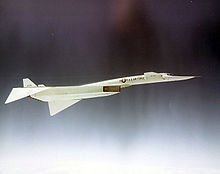- Compression lift
-
 The XB-70 had folding wingtips to enhance both compression lift and directional stability at high speeds.
The XB-70 had folding wingtips to enhance both compression lift and directional stability at high speeds.
In aerodynamics, compression lift refers to an aircraft that uses shock waves generated by its own supersonic flight to generate lift. This can lead to dramatic improvements in lift for supersonic/hypersonic aircraft, which often fly at high altitudes and thus suffer from decreased lift due to the thin air. Clarence A. Syvertson and Alfred J. Eggers discovered this phenomenon 1956 as they analyzed abnormalities at the reentry of nuclear warheads.[1]
The basic concept of compression lift is well known; "planing" boats reduce drag by "surfing" on their own bow wake in exactly the same fashion. Using this effect in aircraft is more difficult, however, because the "wake" does not generate until supersonic speeds, and is highly angled. Aircraft have to be carefully shaped to take full advantage of this effect. In addition the angle of the shock waves varies greatly with speed, making it even more difficult to design a craft that gains significant lift over a wide range of speeds.
To date the only potential production aircraft that used compression lift has been the XB-70 in the 1960s, although with the cancellation of the program after only two prototypes had been built, it ended up being a testbed only. The compression lift decreased the induced drag of the XB-70 about 30%.[2] Designs using compression lift, waveriders, remain an interesting possibility for hypersonic vehicle designs, although only testbed models have been flown.[1]
References
External links
Categories:- Aerodynamics
- Aviation stubs
Wikimedia Foundation. 2010.
